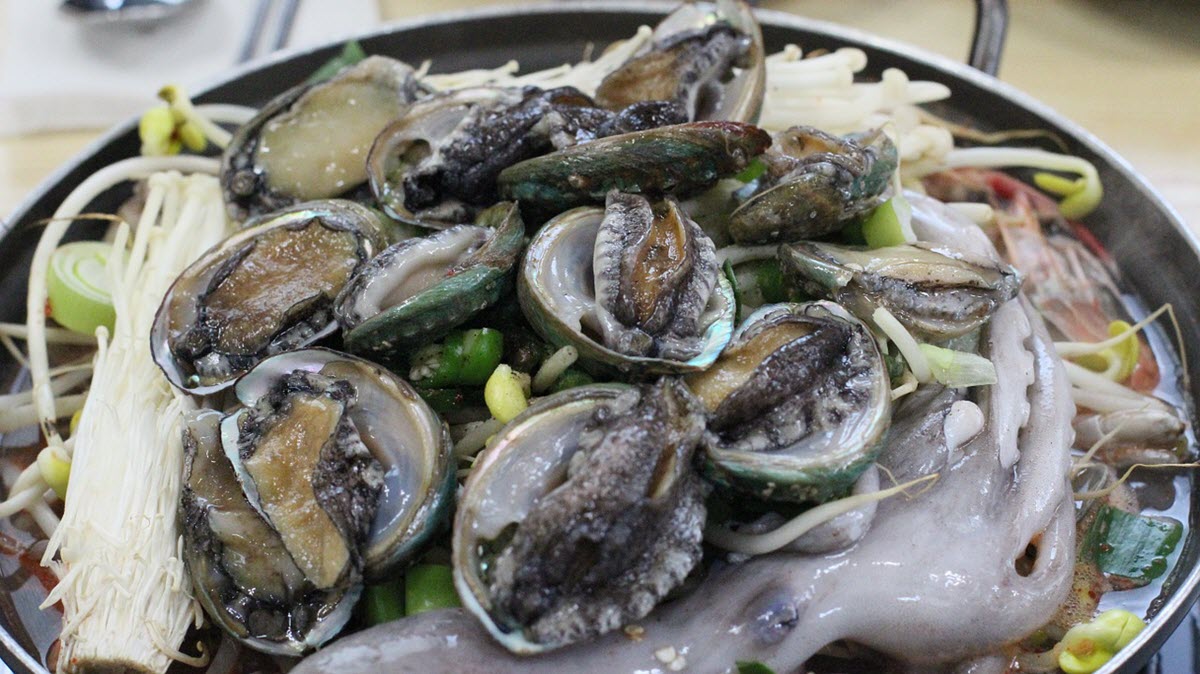Abalone
Australia is one of the main catchers of abalone, a type of sea snail that can be eaten either raw or cooked. In Australia, these creatures are sometimes referred to as muttonfish or muttonshells.
| Scientific classification | |
| Kingdom: | Animalia |
| Phylum: | Mollusca |
| Class: | Gastropoda |
| Subclass: | Vetigastropoda |
| Superfamily: | Haliotoidea |
| Family: | Haliotidae |
| Genus: | Haliotis |
Abalone are marine snails belonging to the family Haliotidae and genus Haliotis. They have shells characterised by a low, open spiral structure, with several open respiratory pores in a row near the shell’s outer edge.
Abalones aren’t just sought after as food; they are also very pretty and used as jewellery or other decorative objects. The inner layer of the shell consists of mother-of-pearl, which in many species of abalone is highly iridescent with a range of strong, changeable colours.
In Australia, Tasmania is especially famous for its abalone and responsible for approximately 25% of the world’s annual abalone harvest. Two of the most popular species is Blacklip abalone (Haliotis rubra) and Greenlip abalone (Haliotis laevigata). Out of a population of approximately 520,00 people, roughly 12,500 Tasmanians engage in recreational blacklip and greenlip collecting. With a recreational Tasmanian abalone license, the bag limit is10 per day, with a total possession limit of 20. Various rules must be adhered to, including rules pertaining to the size of the abalones.

Meyer lemon abalone recipe
Australia is a country where lemons thrive. The three most common lemon variants in the country is Eureka lemon, Lisbon lemon and Meyer lemon. In this abalone recipe, we will use Meyer lemon. If you can’t obtain Meyer lemon, substitute with 50% mandarin orange and 50% any lemon. It won’t taste exactly the same as with Meyer lemon, but it will still be a delicious dish.
Meyer lemon (Citrus x meyeri ‘Meyer’) is thought to be a cross between a true lemon and either a mandarin or common orange.. It’s less acidic than Eureka and Lisbon lemons, and the fruit is small, round and juicy.
Ingredients
1 tablespoon = 20 ml
For the mayonnaise
- 1egg yolk, at room temperature
- 1 tablespoon Dijon mustard
- ½ Meyer lemon, juiced and zested
- 2 tablespoons high quality olive oil
- 125 ml mild flavoured vegetable oil, e.g. sunflower oil
- Salt and pepper, to taste
For the rest
- 2 fresh abalones, cleaned
- 2 eggs
- 2 tablespoons milk
- 200 grams dried breadcrumbs
- 100 grams wheat four
- 500 ml mild flavoured vegetable oil, e.g. sunflower oil
- Salt and pepper, to taste
- Lemon wedges, to serve
Instructions
Making the mayonnaise
- Put the egg yolk in a mixing bowl and whisk it. (You might have to place a wet cloth underneath to keep the bowl from moving around, because you will need both hands for other things than holding down the bowl.)
- Whisk in the Dijon mustard, the lemon juice and the lemon zest.
- Now comes the trick part: Slowly whisk in the olive oil, a very little amount at the time. Then, proceed to do the same with the other oil. Once you have a nice emulsion going, you don’t need to go drop by drop, but you should still take it slow and make sure that the oil is properly absorbed before you add any new.
- Add salt and pepper, to taste. Be careful; you want the lemon to be playing the first fiddle here, not the pepper.
- Divide the mayonnaise into tiny bowls, so each dinner guest can get their own little mayo bowl to dip their abalone in. Keep the mayonnaise bowls in the fridge until its time to eat.
Making the rest
- Hit the cleaned abalones with a meat mallet to crack the foot.
- Cut the abalones into thin strips.
- Pour flour into a plastic bag, together with some salt and pepper.
- In a shallow bowl, whisk together eggs and milk.
- Place breadcrumbs on a tray.
- Put the abalone strips in the flour bag, close the bag, and shake it around to coat the strips well on all sides.
- Take out one abalone strip, dip it the the egg mixture, then coat it with breadcrumbs. Press to make sure it is really well coated with crumbs. Place the coated strip on a plate.
- Repeat the dipping and coating procedure with all the other strips, until all strips are resting on the plate.
- Heat up the oil over high heat in a large wok or similar. To check if the temperature is high enough, throw some breadcrumbs in and see if they start sizzling right away.
- When the wok is hot enough, deep-fry the abalone strips until they are golden. It is best to only put in a handful at the time in the wok, otherwise you will crowd the wok and the temperature will drop too much.If necessary, use a slotted spoon to move the strips around as they are being deep-fried.
- Put the finished strips on a paper towel.
- As soon as all the strips have been deep-fried, serve immediately accompanied with one mayo bowl for each guest and some lemon wedges for your guests to squeeze over their food.
